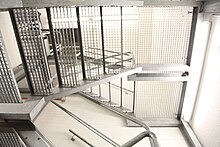Alternative seat of the state government of Baden-Württemberg
The alternative seat of the state government of Baden-Württemberg is a nuclear shelter from the Cold War , camouflaged and built secretly on the outskirts of Oberreichenbach .
Description and history
The nuclear shelter was built as an alternative seat for the state government of Baden-Württemberg in the 1960s in the northern Black Forest on the outskirts of Oberreichenbach, around 50 kilometers as the crow flies from Stuttgart and thus NATO's EUCOM, which is still located there today (now expanded to include Africa and the Middle East). The construction costs at that time amounted to 26.5 million euros.
In the case of a crisis, the state government of Baden-Württemberg with up to 250 people was supposed to find protection in the five-storey bunker . In the event of a disaster , the state government and its working staff could have continued official business here and survived for up to 30 days without external supplies. This use was regularly practiced as part of the WINTEX maneuvers of NATO. Those actually authorized to enter were regularly represented by lower-ranking officials. A communication network with telephone, fax and teletype lines could have ensured the connection with all important authorities in an emergency. An in-house power supply would have provided the energy required for this time. A fully functioning radio studio was housed in the second basement to provide the population with news and information. After the radio masts were destroyed, two special antennas (so-called “Papstfinger” - horizontal and vertical radiators) could be hydraulically extended from the mound of earth above the bunker. In a meeting room, traffic routes and existing infrastructure were shown on large map boards and with overhead projectors. In some special rooms, the doctors belonging to the bunker crew could at least carry out simple operations.
After the end of the Cold War at the beginning of the 1990s, a new use was sought for the then alternative seat of the state government of Baden-Württemberg. In 1994, the state government's bunker began to be converted into an emergency preparedness data center. After the completion of the renovation measures, which cost around 15 million euros, the former ZSVA nuclear bunker became the high-security data center CITA (Center for Information Technology Affairs).
literature
- Jörg Diester: Secret files, government bunker, diary of a state secret . Verlaganstalt Handwerk GmbH, Düsseldorf 2008. ISBN 978-3-869500034
- Ralf H. Dorweiler, Daniela Bianca Gierok: 111 places in the Black Forest that you have to see . Publisher: Emons, HJ (May 24, 2012) ISBN 978-3-89705-950-4
- Martin Kaule: Bunker systems - gigantic buildings in Germany and Europe . Publisher: Weltbild special edition, Augsburg 2013. ISBN 978-3828946972
Web links
- Alternative seat of the constitutional organs of the Federal Republic of Germany / Photo gallery from Aus Weichsitz.de
- 5 to 12 below Germany / Allard van der Hoek
- Geschichtsspuren.de / Article about alternative seats - government bunkers
Individual evidence
- ↑ Thomas Fricke: Baden-Württemberg State Archive, Department Main State Archive Stuttgart - Finding aid R 2/001: Radio broadcasts of the SWF from 1996 - structural view. Retrieved February 22, 2017 .
- ↑ Michael Grube: Alternative seat of the state government of Baden-Württemberg. Retrieved on February 22, 2017 (German).
- ↑ Thomas Fricke: Baden-Württemberg State Archive, Department Main State Archive Stuttgart - Finding aid R 2/001: Radio broadcasts of the SWF from 1996 - structural view. Retrieved February 22, 2017 .
- ↑ The state administration sends sensitive data to the bunker In: Government Computing. July 21, 2003
- ↑ "From government bunker to alternative data center" The state secret of Oberreichenbach: from government bunker to alternative data center
Coordinates: 48 ° 43 ′ 42.4 " N , 8 ° 39 ′ 58.9" E





